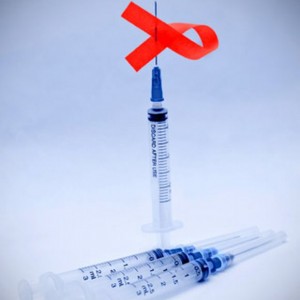 As recently as October 2011, clinical trials of HIV vaccines have shown that it may indeed be possible to reduce HIV to minor infection status but it’s a bit premature for any big celebrations. Despite breakthroughs in research, the best way to protect oneself against HIV infection and other sexually transmitted infections is still to use a condom during sex.
As recently as October 2011, clinical trials of HIV vaccines have shown that it may indeed be possible to reduce HIV to minor infection status but it’s a bit premature for any big celebrations. Despite breakthroughs in research, the best way to protect oneself against HIV infection and other sexually transmitted infections is still to use a condom during sex.
In a Phase I clinical trial of an MVA-B HIV vaccine developed by scientist at the Spanish Superior Scientific Research Council in Madrid, the results showed that out of 30 healthy volunteers (not infected with HIV) who were given the vaccine, 90% developed immunity against the virus, and 85% maintained their immunity for a year. According to the study, if this vaccine also passes Phase II and Phase III trials, and is produced for distribution, HIV could have the same sort of status as the herpes virus has today.
The researchers have said that the vaccine is made up of pieces of the HIV virus’ genetic material. The vaccine functions like it is showing the immune system a picture of the “enemy”, so that if it ever comes in contact with it, it knows how to fight it. Moreover, the trial participants could not accidentally contract HIV because the pieces in the vaccine cannot replicate.
Although this vaccine is a breakthrough in HIV treatments/cure research, it is by no means the only avenue that will be explored. This vaccine will eventually be a therapeutic vaccine, which means it will be given to people who are already HIV positive, and could take the place of current anti-retroviral drugs that have to be taken each day as pills. Perhaps the treatment would be reduced to one injection a year, or less. There are also other options such as using direct gene therapy as treatment or as preventative care – offered to HIV negative people who regularly put their sexual health at risk such as sex-workers.
HIV is such a complex virus that any insight into how it works and how to treat it are significant steps forward, while at the same time, the more scientists learn, the more they see that there is to continue to discover.
In 2009, the U.S. Military HIV Research Program and the Thai government published results of a 3 year long HIV vaccine trial in which there were 16,000 volunteer subjects. According to the researchers, the vaccinated adults (half of the study group), all of whom were HIV negative prior to injection, had 32% less chance of becoming infected than those who were given the placebo. However, according to other HIV/AIDS scientists, the results though they may be statistically significant, may not end up being clinically significant due to cost and difficulty of manufacturing the vaccine, and low effectiveness. Moreover, the vaccine was based on the strains of HIV common in Thailand, which are different than the strain prevalent in Africa.
In May of 2011, a successful vaccine trial was conducted on macaque monkeys which are vulnerable to simian immunodeficiency virus (SIV) the monkey equivalent of HIV. This vaccine was based on a genetically modified version of another monkey virus, rhesus cytomegalovirus (CMV). Although the results of this test showed that the vaccine afforded immunity to SIV to about half of the subjects for up to one year, much more research has to be done to ensure the safety of the vaccine before it can be tried on humans. Introduction of CMV into humans may not be completely safe, because that virus itself is not completely benign and may accidentally cause contraction of other diseases in humans.
The path to where we are today has been long and hard. HIV vaccine research has been and continues to be one of the biggest fields of research of vaccination/infectious disease curing. Since the discovery of HIV as the cause of AIDS, a lot of focus has been paid upon the development of a vaccine, but as of yet, there is nothing fully effective. Both governmental and non-governmental forces are at work on the development and discovery of a cure for this virus which is the cause of AIDS, one of the main problems on the planet. HIV/AIDS twin pandemics are a big issue globally.
In Armenia, currently there are 1136 number of people infected with HIV and 543 whose infections have developed into AIDS. Though the outbreaks are well controlled by drugs and preventative care, for example, for unborn children of women with HIV, in many places across the globe, the numbers of those infected are so high that highly individualized care is not a feasible option. HIV and AIDS are global issues and require the attentions and efforts of people across the world to raise awareness. Every single person who practices and/or teaches safe sex habits is single handedly helping decrease the likelihood of the spread of the disease. December 1st is World AIDS Day, and people across the world mark this day with actions such as HIV/AIDS education and advocacy for the rights of those who are HIV positive or have developed AIDS.
Nieri Avanessian
Used resources: Fox News, Voice of America, The Guardian, BBC News, MHRP, Medscape, BBC News




Two types of HIV have been characterized: HIV-1 and HIV-2. HIV-1 is the virus that was initially discovered and termed both LAV and HTLV-III. It is more virulent, more infective, and is the cause of the majority of HIV infections globally. The lower infectivity of HIV-2 compared to HIV-1 implies that fewer of those exposed to HIV-2 will be infected per exposure.
The statistics I find most abeirlle are those on the CIA Worldbook website regarding South Africa’s population statistics. The CIA uses satellite surveillance to compile their records. It makes very interesting reading and is completely different from the formal government statistics’ us poor fools on the ground are being forced to rely on, even if they are being dished out by some of the most grossly incompetent and politically-correct government appointees in the world. As far as the Aids-EPIDEMIC is concerned, I refuse to debate any denialists, from Mbeki on down. It’s not worth wasting one’s time on. One also does not need to be taken by the hand and led to government hospitals to try and find people who are dying of AIDS. One merely needs to read the obituaries in the Sowetan, and view the burial statistics at all the country’s cemeteries, to realise that young people are dying at unprecedented rates from deeply mysterious diseases. Healthy young people don’t die at such huge numbers from disease in normal society. The only reason South Africa still shows a growth rate’ of less than 1 percent, is because it’s borders have been thrown wide open to migration from the rest of the continent, says the CIA.